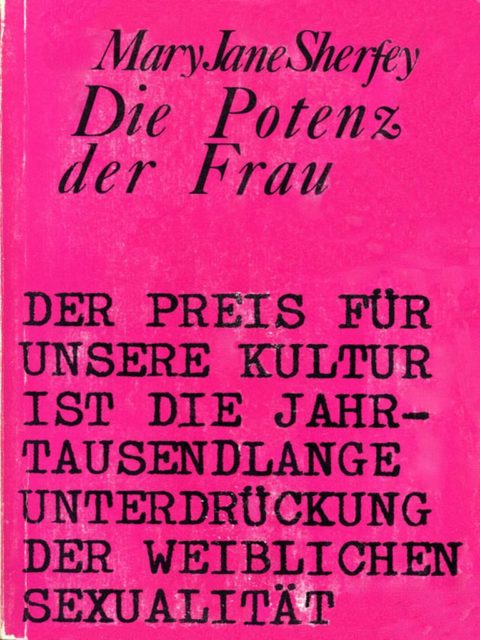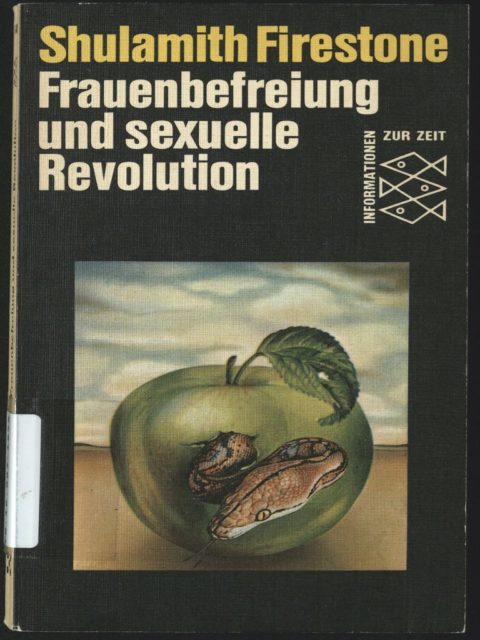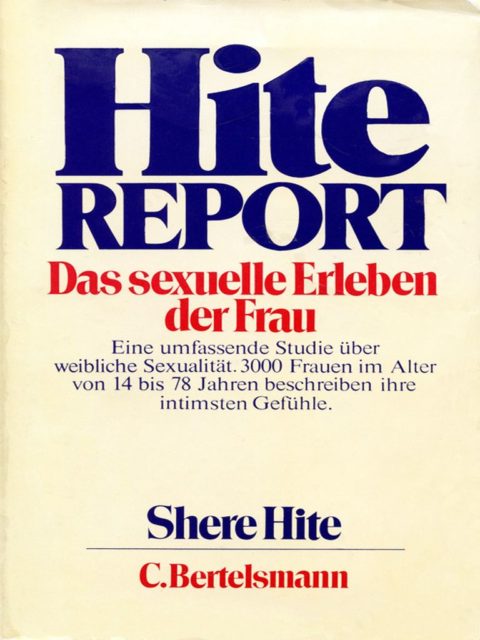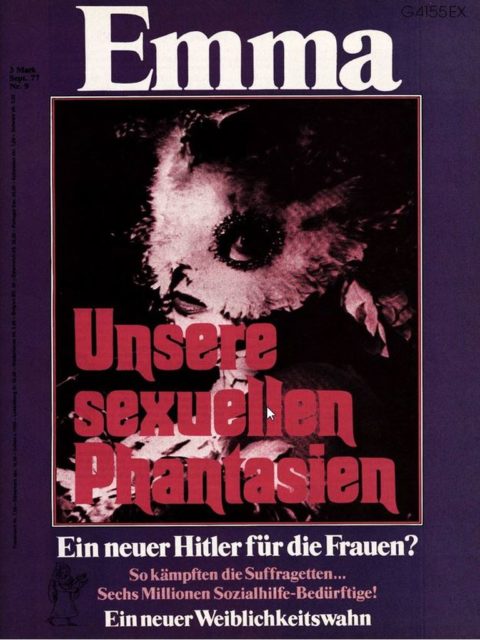Sexuality and love are the central issues of autonomous feminist debate. The so-called “sexual revolution” by the ‘68ers had not challenged the balance of power between the sexes: whereas a woman had once been considered to belong to one man, now she ought to belong to all men (“Wer zweimal mit derselben pennt, gehört schon zum Establishment”). It was the women’s movement that questioned the function of power in sexuality and unmasked the fact that love disguises power structures. The primacy of coitus was questioned by feminists, and the clitoris discovered as the physical centre of (female) sexual desire. Thus, the women’s movement triggered the true sexual revolution.

1971: Millett – Sexuality is Political
Kate Millett’s Sexual Politics1 is published in German as Sexus und Herrschaft2. In this book, Millet coins the term “sexual politics”, which describes all areas where sexuality is political: from pornography (Millett cites the example of Henry Miller’s novel Sexus3), abuse, and rape to prostitution. Millett explains that the power relationship between men and women, and the biologistic attribution of gender characteristics, is comparable to the balance of power between whites and blacks.
1973: Reform of the Sex Crime Legislation
Under the influence of the ‘68ers and the women’s movement, the social democrat coalition reforms sex crime legislation. In this Vierte Große Strafrechtsreform ‘normal’ pornography is exempt from punishment (for more see our text on pornography), and the prosecution of ‘pimping’ is complicated by its vague definition (more on prostitution here). However, the legislature also reinterprets sex offences: they are no longer considered “crimes or offences against morality”, but “criminal offences against sexual self-determination”. Thus, the legal property that is to be protected is no longer the morals or ‘honour’ of a woman (and thereby of the man who lays claim to it), but rather the woman’s right to control over her body.

Criminal offences like “Kuppelei” or “procuration” are abolished (until now, parents or hoteliers who allowed unmarried couples to spend the night together under their roof had made themselves liable to prosecution).
1974: “At the beginning, there was woman.”
The Nature and Evolution of Female Sexuality (1966, USA) by Mary Jane Sherfey, a student of Alfred Kinsey, is published in German as Potenz der Frau4. The sexologist points out that the embryo is initially female and only differentiates into specifically male or female anatomical forms after the fifth week: “At the beginning, there was woman.” Sherfey situates the clitoris as the physical centre of female desire and as a parallel to the male penis. For Sherfey, the “sexual liberation” of the 1960s was nothing more than a “new, perfidious version of the suppression of female sexuality” because it ignored the clitoris.

1975: Der kleine Unterschied
Der „kleine Unterschied“ und seine großen Folgen5 by Alice Schwarzer is published. The book sparks a virulent social debate and is the first feminist best-seller and long-seller to date. On the basis of 17 exemplary case studies (in the form of protocols), Schwarzer analyses the function of the “love monopoly” that men have over women. She addresses women’s inner conflict and their (self-)oppression “in the name of love”. It is Schwarzer’s third book – after a first about the function of the prohibition of abortion6 and a second about work and housework7 (today “work-life balance”). In her introduction, Schwarzer writes: “Sexuality is the crux of the women’s issue. Sexuality is simultaneously a mirror and an instrument of women’s oppression in all areas of life.”8 Schwarzer – who refers, among others, to Millett, Sherfey, and Firestone – argues for liberation from “forced hetereosexuality” and a free, non-normative sexuality. The book is published in nine languages, and even in countries as far afield as Brazil and Japan. Schwarzer states retrospectively: “The issues of love, sexuality, and violence as well as the taboo of female lust are universal for women, regardless of class or race.”9

1975: Firestone and Stefan
Shulamith Firestone’s The Dialectic of Sex10 (1970, USA) is only now published in German as Frauenbefreiung und sexuelle Revolution11. Firestone analyses the role of love and writes: “(Male) Culture was built on the love of women, and at their expense. Women provided the substance of those male masterpieces; and for millennia they have done the work and suffered the costs, of one-way emotional relationships the benefits of which went to men and to the work of men.”12 Firestone demands that “the end goal of feminist revolution must be […] not just the elimination of male privilege but of the sex distinction itself”. She argues for an androgynous idea of humankind.

Verena Stefan’s book Häutungen13 is published with the newly founded feminist publishing house Frauenoffensive. The Swiss physiotherapist had been active in the Berlin-based women’s group Brot und Rosen since 1970. The inspiration for Häutungen comes from a contribution that the group was supposed to write for the feminist journal Kursbuch entitled Wie ist die Emanzipation der Frau mit der Beziehung zu einem Mann zu vereinbaren?14 Stefan writes about self-abandonment in relationships with men, her compliance with the (sexual) wishes of her male partners, and finally her turn to relationships with women. Stefan addresses autobiographical experiences and thus creates the genre “Betroffenheitsliteratur” (“affectedness” literature, connoting some form of victimisation). Häutungen becomes a best-seller and cult book of the women’s movement.
1976: The Hite-Report
The American doctoral student Shere Hite publishes her thesis as Hite-Report15, for which she interviewed around 3,000 women about their sexuality. The answers turn common clichés on their head. The media in Germany also reports on Hite’s study.16

1977: Female Masochism
In a cover story about Sexuelle Phantasien ‘sexual fantasies’ in EMMA, the psychoanalyst Margarete Mitscherlich analyses the causes of ‘female masochism’ and protests against biologistic attributions that claim women are ‘by nature’ masochistic in what will become a seminal text. “In psychoanalysis, it has often been argued that women are inherently masochistic, i.e. that they display a tendency to self-torture and pleasure in suffering”, writes Mitscherlich. “Women’s ‘typically masochistic’ behaviour is by now recognised as the psychological processing of pathological social conditions […] The fact that masochistic fantasies are so abundant among women must go back to their century-long domestic and social bondage.”17

1978: Sex Education in School
The Federal Constitutional Court passes a motion to introduce sex education into the classroom: “Individual sex education is first and foremost part of the natural parental rights of care and custody; however, the state is entitled to carry out sex education in school due to its educational mandate.” (see Beschluss des Bundesverfassungsgerichts, 21.12.1977).
1978: Realitiy vs. Sexual Fantasy
My Secret Garden: Women’s Sexual Fantasies (1973, USA) by the American Nancy Friday is published in Germany as Die sexuellen Phantasien der Frauen18. The journalist explores the depths of the interplay between reality and (sexual) fantasy and of women’s emotional masochism.

1981: Meulenbelt – Voor onszelf
Voor onszelf, Vanuit vrouwen bekeken (1979, Netherlands) by the Dutchwoman Anja Meulenbelt is published in German as Für uns selbst: Körper und Sexualität aus Sicht von Frauen19.
1980: Our Bodies, ourselves
Based on the initiative of feminists, Our Bodies, ourselves20 is published in Germany as Unser Körper – Unser Leben. Ein Handbuch von Frauen für Frauen21. The book deals with various topics relating to the female body from a feminist perspective: from contraception and sexually transmitted diseases, psychotherapy and medication, to nutrition and body image. The book had already been regarded as a key milestone by German readers when it was published 11 years previously in the USA by the Boston Women’s Health Book Collective. The German edition will reach a circulation of 300,000 copies by the beginning of the 1990s; the second volume22 – published in 1988 – will be similarly successful.
![Externer Link: Sexualität (1982). - Mikich, Sonia [Hrsg.] ; Schwarzer, Alice [Hrsg.]. Köln : Emma-Frauen-Verlag. (FMT-Signatur: KO.11.027-1982) Externer Link: Sexualität (1982). - Mikich, Sonia [Hrsg.] ; Schwarzer, Alice [Hrsg.]. Köln : Emma-Frauen-Verlag. (FMT-Signatur: KO.11.027-1982)](http://frauenmediaturm.de/wp-content/uploads/2018/06/EMMA_Sonderband_Sexualität-480x640.jpg)
1982: EMMA’s Special Issue on Sexuality
Sexualität23 – a special issue of EMMA that deals with the consequences of the feminist sexual revolution – is published. It addresses female desire and frigid men as well as heterosexuality, homosexuality, bisexuality, and abstinence. It is also concerned with “the erotic as shackling and unshackling” (Schwarzer). And with sadomasochism. The latter – in response to the new freedom of female desire? – causes a media hype and also has an effect on the women’s scene24.
1983: Women, the Loving Sex?
In the Name of Love25 (1981, UK) by the British feminist Jill Tweedie is published in Germany as Die sogenannte Liebe. Von den Zwängen der Zweisamkeit26. In her book, Tweedie calls women the “loving sex”. She writes: “Love is a queendom colonised by men and in the Governor’s Palace, women scrub the floors.”27

What happens next?
The subject of sexuality and love is from a feminist point of view too broad to capture in a few sentences. In summary, it can be said: we have taken two steps forward and one step back. The new sexual freedoms of the 1970s and early 1980s have given way to new norms. Although the women’s movement promoted a non-normative, free sexuality in the 1970s, labels have returned: people are heterosexual or homosexual, queer or trans. The only change: instead of two boxes, there are now several. At the same time, “communicative sexuality” is on the rise between the sexes. Sexual violence is, however, still present, only further fuelled by the ubiquity of (violent) pornography. And critique of the repressive aspect of love has grown quieter.
References
1 Millet, Kate (1985): Sexual Politics. - London: Virago Press. (FMT Shelf Mark: FE.10.210)
2 Millet, Kate (1971): Sexus und Herrschaft : die Tyrannei des Mannes in unserer Gesellschaft. - München : Desch. (FMT Shelf Mark: FE.10.225)
3 Miller, Henry (1970): Sexus : Roman. - Hamburg : Rowohlt.
4 Sherfey, Mary Jane (1974): Die Potenz der Frau : Wesen und Evolution der weiblichen Sexualität. - Luxemburg : Clepto-Reprint. (FMT Shelf Mark: KO.11.015)
5 Schwarzer, Alice (1973): Der "kleine Unterschied" und seine großen Folgen : Frauen über sich : Beginn einer Befreiung. - Frankfurt am Main : Fischer-Taschenbücher. (FMT Shelf Mark: FE.10.226; various editions available)
6 Schwarzer, Alice (1971): Frauen gegen den § 218 : 18 Protokolle, aufgezeichnet von Alice Schwarzer. - Frankfurt am Main : Suhrkamp. (FMT Shelf Mark: SE.11.158)
7 Frauenarbeit - Frauenbefreiung : Praxis-Beispiele und Analysen (1973). - Schwarzer, Alice [ed.]. Frankfurt am Main : Suhrkamp. (FMT Shelf Mark: AR.07.040-1973)
8 Schwarzer, Alice (1975): Der "kleine Unterschied" und seine großen Folgen : Frauen über sich : Beginn einer Befreiung. - Frankfurt am Main: Suhrkamp, S. 7. (FMT-Signatur: FE.10.226; versch. Auflagen vorhanden)
9 Schwarzer, Alice (2011): Lebenslauf. - Köln : Kiepenheuer & Witsch, S. 312. (FMT Shelf Mark: BG.03.SCHWAR-A.004)
10 Firestone, Shulamith (1988): The Dialectic of Sex : the Case for Feminist Revolution. - London : Women's Press. (FMT Shelf Mark: FE.10.007-1988)
11 Firestone, Shulamith (1975): Frauenbefreiung und sexuelle Revolution. - Frankfurt am Main : Fischer-Taschenbuch-Verlag. (FMT Shelf Mark: FE.10.007-1975)
12 Ibid., p.120.
13 Stefan, Verena (1976): Häutungen. - München : Fischer-Taschenbuch-Verlag. (FMT Shelf Mark: FE.03.108; various editions available)
14 In an interview with the taz in 2008, Verena Stefan explains why the text was never written: “Our Brot und Rosen group was supposed to contribute an article for the journal Kursbuch entitled ‘Wie ist die Emanzipation der Frau mit der Beziehung zu einem Mann zu vereinbaren?’ We had good laugh because we thought it likely that female emancipation and being in a relationship with a man were not compatible. We didn’t get around to writing the text because in 1974 we organised the big teach-in against § 218 in Berlin.” Aus: Oestreich, Heide ; Stefan, Verena (2008): „Ich bin keine Frau. Punkt.“. – In: Die Tageszeitung, 10.05.2008, retrieved from: http://www.taz.de/!5182326/
15 Hite, Shere: Hite-Report : das sexuelle Erleben der Frau (1977). - München : Goldmann. (FMT Shelf Mark: KO.11.012; various editions available)
16 See Pressedokumentation: Sexualität II, 1970-1993. (FMT Shelf Mark: PD-KO.11.02, Kapitel 1) and Hite-Report: Abnabeln von Doktor Freud (1977). - In: Der Spiegel, Nr. 37, S. 182 - 185.Retrieved from: www.spiegel.de/spiegel/print/d-40831475.html
17 Mitscherlich, Margarete (1977): Sind Frauen masochistisch?. - In: EMMA, Nr. 9, p. 11f..
18 Friday, Nancy (1978): Die sexuellen Phantasien der Frauen : eine umfassende Untersuchung über einen bisher verborgenen Bereich der weiblichen Erotik und Sexualität. - Bern : Scherz. (FMT Shelf Mark: KO.11.007)
19 Meulenbelt, Anja (1981): Für uns selbst : Körper und Sexualität aus der Sicht von Frauen. - München : Frauenoffensive. (FMT Shelf Mark: KO.11.029)
20 Our Bodies, Ourselves : a Book by and for Women (1973). - Women's Health Book Collective [ed.]. New York : Simon & Schuster. (FMT Shelf Mark: KO.01.001)
21 Unser Körper, unser Leben : ein Handbuch von Frauen für Frauen (1984). - Lorenzen, Kerstin [ed.] ; Menzel, Beate [ed.]. "Bd." 1, Reinbek bei Hamburg : Rowohlt-Taschenbuch-Verlag. (FMT Shelf Mark: KO.01.002-Bd.1)
22 Unser Körper, unser Leben : ein Handbuch von Frauen für Frauen (1981). - Lorenzen, Kerstin [ed.] ; Menzel, Beate [ed.]. "Bd." 2, Reinbek bei Hamburg : Rowohlt-Taschenbuch-Verlag. (FMT Shelf Mark: KO.01.002-Bd.2)
23 Sexualität (1982). - Mikich, Sonia [ed.] ; Schwarzer, Alice [ed.]. Köln : Emma-Frauen-Verlag. (FMT Shelf Mark: KO.11.027-1982)
24 Siehe Pressedokumentation: Sadomasochismus, 1977-1990. (FMT-Signatur: PD-KO.11.05, Kapitel 2)
25 Tweedie, Jill (1979): In the Name of Love : A Study of Sexual Desire. - London : Random House.
26 Tweedie, Jill: Die sogenannte Liebe : von den Zwängen der Zweisamkeit. - Reinbek bei Hamburg : Rowohlt. (FMT Shelf Mark: KO.01.016)
27 Ibid., p. 51.
Date of the last linkcheck: 17.07.2017
Selective Bibliography
Documents online
Viertes Gesetz zur Reform des Strafrechts, 23.11.1973
Unsere sexuellen Phantasien (1977). - In: EMMA, Nr. 9.
Hite-Report: Abnabeln von Doktor Freud (1977). - In: Der Spiegel, Nr. 37, S. 182 - 185.
Dossier : What about sex? (2010). - In: EMMA, Nr. 2; S. 106 - 146.
Dossier : Klitoris - Die Königin der Lust (2013). - In: EMMA, Nr. 4, S. 80 - 101.
Recommendations
Millet, Kate (1971): Sexus und Herrschaft : die Tyrannei des Mannes in unserer Gesellschaft. - München : Desch. (FMT Shelf Mark: FE.10.225)
Beauvoir, Simone de (1972): Das andere Geschlecht : Sitte und Sexus der Frau. - Reinbek bei Hamburg : Rowohlt. (FMT Shelf Mark: FE.10.209-1972; various editions available)
Schwarzer, Alice (1973): Der "kleine Unterschied" und seine großen Folgen : Frauen über sich : Beginn einer Befreiung. - Frankfurt am Main : Fischer-Taschenbücher. (FMT Shelf Mark: FE.10.226; various editions available)
Firestone, Shulamith (1975): Frauenbefreiung und sexuelle Revolution. - Frankfurt am Main : Fischer-Taschenbuch-Verlag. (FMT Shelf Mark: FE.10.007-1975)
Stefan, Verena (1976): Häutungen. - München : Fischer-Taschenbuch-Verlag. (FMT Shelf Mark: FE.03.108; various editions available)
Hite, Shere: Hite-Report : das sexuelle Erleben der Frau (1977). - München : Goldmann. (FMT Shelf Mark: KO.11.012; various editions available)
Friday, Nancy (1978): Die sexuellen Phantasien der Frauen : eine umfassende Untersuchung über einen bisher verborgenen Bereich der weiblichen Erotik und Sexualität. - Bern : Scherz. (FMT Shelf Mark: KO.11.007)
Unser Körper, unser Leben : ein Handbuch von Frauen für Frauen (1984). - Lorenzen, Kerstin [Hrsg.] ; Menzel, Beate [Hrsg.]. "Bd." 1, Reinbek bei Hamburg : Rowohlt-Taschenbuch-Verlag. (FMT Shelf Mark: KO.01.002-Bd.1)
Hite, Shere (1991): Hite-Report : das sexuelle Erleben des Mannes. - Bindlach : Gondrom. (FMT Shelf Mark: KO.11.013)
Sexuelle Vielfalt und die UnOrdnung der Geschlechter : Beiträge zur Soziologie der Sexualität (2015). - Lewandowski, Sven [Hrsg.] ; Koppetsch, Cornelia [Hrsg.]. Bielefeld : Transcript. (FMT Shelf Mark: KO.11.172)
FMT Press Documentation
Press Documentation Sex & Love: PDF-Download
The FMT press documentation is thematically structured and indexed. It comprises articles of the general public press, feminist press and other documents, such as leaflets and archival documents.
Selected FMT-Sources (lists)
Selected literature Sex & Love: PDF-Download
Related Topics
Lesbian and Feminist - Female and Homosexual: Becoming Visible
Lesbian and Feminist - Female and Homosexual: Becoming Visible
Female homosexuality was still a taboo at the beginning of the 1970s. The women’s movement made lesbians visible. › mehr
Pornography - Sexual Desire Vs. Sexualised Misogyny
Pornography - Sexual Desire Vs. Sexualised Misogyny
The feminist debate about pornography was divided: Some considered it unproblematic, but most opposed it as verbal and visual sexual violence. › mehr
Prostitution - A 'Job Like Any Other'?
Prostitution - A 'Job Like Any Other'?
For some, it is “the oldest trade in the world” – for others, a violation of human dignity and 'white slavery'. › mehr





